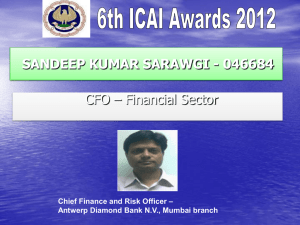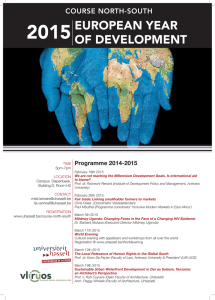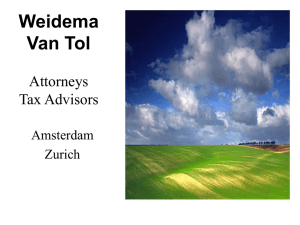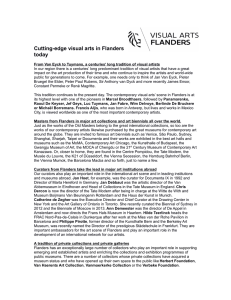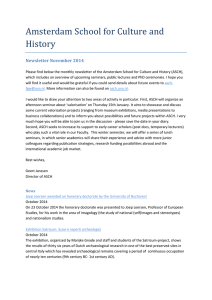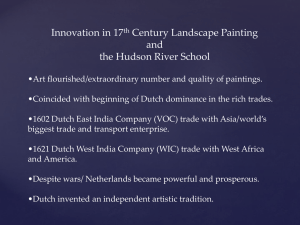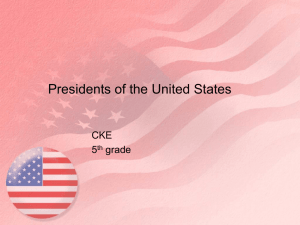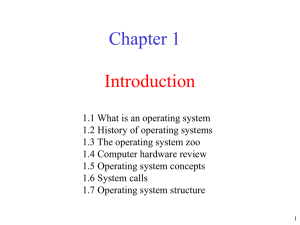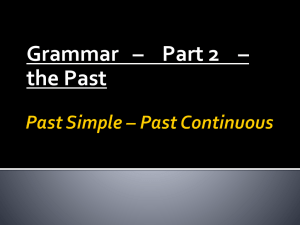Karen_Vannieuwenhuyze - Onderzoekschool Politieke Geschiedenis
advertisement
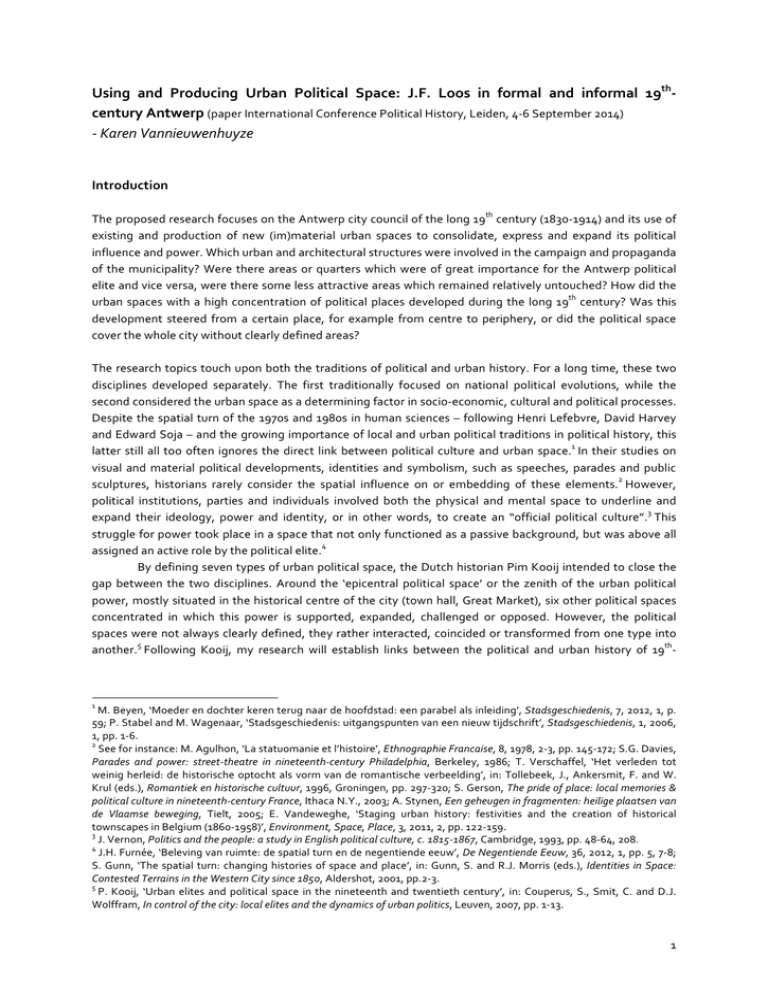
Using and Producing Urban Political Space: J.F. Loos in formal and informal 19th-­‐ century Antwerp (paper International Conference Political History, Leiden, 4-­‐6 September 2014) -­‐ Karen Vannieuwenhuyze Introduction th The proposed research focuses on the Antwerp city council of the long 19 century (1830-­‐1914) and its use of existing and production of new (im)material urban spaces to consolidate, express and expand its political influence and power. Which urban and architectural structures were involved in the campaign and propaganda of the municipality? Were there areas or quarters which were of great importance for the Antwerp political elite and vice versa, were there some less attractive areas which remained relatively untouched? How did the th urban spaces with a high concentration of political places developed during the long 19 century? Was this development steered from a certain place, for example from centre to periphery, or did the political space cover the whole city without clearly defined areas? The research topics touch upon both the traditions of political and urban history. For a long time, these two disciplines developed separately. The first traditionally focused on national political evolutions, while the second considered the urban space as a determining factor in socio-­‐economic, cultural and political processes. Despite the spatial turn of the 1970s and 1980s in human sciences – following Henri Lefebvre, David Harvey and Edward Soja – and the growing importance of local and urban political traditions in political history, this 1 latter still all too often ignores the direct link between political culture and urban space. In their studies on visual and material political developments, identities and symbolism, such as speeches, parades and public 2 sculptures, historians rarely consider the spatial influence on or embedding of these elements. However, political institutions, parties and individuals involved both the physical and mental space to underline and 3 expand their ideology, power and identity, or in other words, to create an “official political culture”. This struggle for power took place in a space that not only functioned as a passive background, but was above all 4 assigned an active role by the political elite. By defining seven types of urban political space, the Dutch historian Pim Kooij intended to close the gap between the two disciplines. Around the ‘epicentral political space’ or the zenith of the urban political power, mostly situated in the historical centre of the city (town hall, Great Market), six other political spaces concentrated in which this power is supported, expanded, challenged or opposed. However, the political spaces were not always clearly defined, they rather interacted, coincided or transformed from one type into 5 th another. Following Kooij, my research will establish links between the political and urban history of 19 -­‐ 1 M. Beyen, ‘Moeder en dochter keren terug naar de hoofdstad: een parabel als inleiding’, Stadsgeschiedenis, 7, 2012, 1, p. 59; P. Stabel and M. Wagenaar, ‘Stadsgeschiedenis: uitgangspunten van een nieuw tijdschrift’, Stadsgeschiedenis, 1, 2006, 1, pp. 1-­‐6. 2 See for instance: M. Agulhon, ‘La statuomanie et l’histoire’, Ethnographie Francaise, 8, 1978, 2-­‐3, pp. 145-­‐172; S.G. Davies, Parades and power: street-­‐theatre in nineteenth-­‐century Philadelphia, Berkeley, 1986; T. Verschaffel, ‘Het verleden tot weinig herleid: de historische optocht als vorm van de romantische verbeelding’, in: Tollebeek, J., Ankersmit, F. and W. Krul (eds.), Romantiek en historische cultuur, 1996, Groningen, pp. 297-­‐320; S. Gerson, The pride of place: local memories & political culture in nineteenth-­‐century France, Ithaca N.Y., 2003; A. Stynen, Een geheugen in fragmenten: heilige plaatsen van de Vlaamse beweging, Tielt, 2005; E. Vandeweghe, ‘Staging urban history: festivities and the creation of historical townscapes in Belgium (1860-­‐1958)’, Environment, Space, Place, 3, 2011, 2, pp. 122-­‐159. 3 J. Vernon, Politics and the people: a study in English political culture, c. 1815-­‐1867, Cambridge, 1993, pp. 48-­‐64, 208. 4 J.H. Furnée, ‘Beleving van ruimte: de spatial turn en de negentiende eeuw’, De Negentiende Eeuw, 36, 2012, 1, pp. 5, 7-­‐8; S. Gunn, ‘The spatial turn: changing histories of space and place’, in: Gunn, S. and R.J. Morris (eds.), Identities in Space: Contested Terrains in the Western City since 1850, Aldershot, 2001, pp.2-­‐3. 5 P. Kooij, ‘Urban elites and political space in the nineteenth and twentieth century’, in: Couperus, S., Smit, C. and D.J. Wolffram, In control of the city: local elites and the dynamics of urban politics, Leuven, 2007, pp. 1-­‐13. 1 th century Antwerp. In short, I will analyse the local Antwerp political culture of the long 19 -­‐century spatially and vice versa, the local political spaces culturally. Throughout the centuries, and certainly until the French Revolution, religious institutions settled down across Antwerp and strongly influenced the life of citizens. Completely undisturbed, the Catholics could 6 th overload the cityscape with all kinds of material symbols. Consequently, in the 19 century, new political ideologies like liberalism, flamingantism and socialism, had to compete against this urban and architectural resources already available to the Catholic political wing. Though, the more, for example, the liberals obtained th control over the urban space, the bigger the urge of the Catholics to strengthen its position again. In 19 -­‐ century Antwerp, all these aforementioned political ideologies saw the light of day and were sooner or later represented in the city council. This project will thus consider how the physical and mental city transformed into a battleground and how differently or similarly political parties and individuals integrated this space in their campaigns to convince and inspire the citizens of and by their beliefs. Such an integral approach will th refine the traditional conception of 19 -­‐century Antwerp controlled by a liberal political elite and contested by 7 Catholic and Meetingist opponents. As Oliver Zimmer suggested, the interaction between political actors was not only characterised by antagonism, but also by mutual accommodation or “efforts […] to engage with each 8 other in nonantagonistic ways”. The political struggle between politicians and parties could be intense, while at other times they needed each other’s help and became indispensable allies. For example, as capital of the Flemish Movement, Antwerp was a hotbed of flamingants who all pursued a same common purpose, but belonged to the liberal as well as to the Catholic, Meetingist or socialist associations. With the restoration and reconstruction of the city hall, the erection of many public sculptures and the well-­‐considered street naming the subsequent city councils attempted to claim the (im)material urban th space, each in their own way. In the second half of the 19 century, the municipality restored and renovated 9 the exterior and interior of the obsolete town hall. It pointed out the importance of this building and the Great Market as epicentre of its political power to the outside world and most importantly to its own citizens. While, among other things, new and recovered decorations, portraits and emblems represented and concentrated the urban political power, the city government was, in view of the limited space, forced to decentralise most of its functions and services across the city. The restoration, renovation and expansion of the town hall (in)directly materialised the pre-­‐established status, ideals and power of the Antwerp city council. This underlying ideology also returned in other urban structures, like statues and street names. As reflections of prevailing political and ideological beliefs, political actors and groups erected and inaugurated statues at well-­‐considered Antwerp spaces in order to influence citizens in short as well as in long terms. In the case of th Belgum, many (art) historians traditionally linked the 19 -­‐century statuomanie to emerging feelings of 6 de See for instance: C. de Clercq, ‘Kerkelijk leven’, in: Antwerpen in de XVII eeuw, Antwerp, 1989, pp. 27-­‐68; K. De Raeymaecker, ‘Aspecten van de contrareformatie te Antwerpen in de zeventiende eeuw’, in: ibid.; pp. 69-­‐99; C. de Clercq, de ‘Het kerkelijk leven’, in: : Antwerpen in de XVIII eeuw: instellingen, economie, cultuur, Antwerp, 1952, pp. 123-­‐155; J. Andriessen, ‘Katholiek herstel en Contrareformatie’, in: Van Isacker, I. and R. Van Uytven, Antwerpen: twaalf eeuwen geschiedenis en cultuur, Antwerp, 1986, pp. 183-­‐191; P. Huvenne, ‘De artistieke burcht van de Contrareformatie (1609-­‐ 1648)’, in: Asaert, G., Grieten, S., and T. Grobet (eds.), Het grote geschiedenisboek van Antwerpen, Antwerp, 2010, pp. 123-­‐133; K. Van Honacker, ‘De grijze zeventiende eeuw (1648-­‐1715)’, in: ibid., pp. 135-­‐145; I. Bertels, T. Bisschops and B. Blondé, ‘Stadslandschap: ontwikkelingen en verwikkelingen van een stedelijke ruimte’, in: Bertels, I., De Munck, B. and H. Van Goethem (eds.), Antwerpen: biografie van een stad, Antwerp, 2011, pp. 32-­‐35. 7 See for instance: Houtman-­‐De Smedt, ‘Continuïteit en discontinuïteit in het politieke leven’, in: Van Isacker, I. and R. Van Uytven, Antwerpen, pp. 250-­‐268; L. Wils, ‘De hoofdstad van de Vlaamse beweging’, in: ibid., pp. 314-­‐321; J. Van Gerven, ‘Stad, adel en kerk als ideologische breekpunten in de strijd tussen katholieken en liberalen in de negentiende eeuw: de Antwerpse ervaring’, Bijdragen tot de geschiedenis, 75, 1992, 1-­‐2, pp. 63-­‐83; L. Hancké, ‘De Antwerpse politieke wereld tussen 1863 en 1930’, in: M. Nauwelaerts, C. Terryn C. and P. Verbraeken (eds.), De panoramische droom: Antwerpen en de wereldtentoonstellingen 1885, 1894, 1930, Antwerp, 1993, pp. 113-­‐122; G. Deneckere, Geuzengeweld: antiklerikaal straatrumoer in de politieke geschiedenis van België, 1831-­‐1914, Brussels, 1998. 8 O. Zimmer, ‘Beneath the “culture war”: Corpus Christi processions and mutual accommodation in the Second German Empire’, The journal of modern history, 82, 2010, 2, p. 295. 9 F. Prims, Het stadhuis te Antwerpen: geschiedenis en beschrijving, Antwerp, 1930, pp. 42-­‐44; J. Lampo, Het stadhuis van Antwerpen, Brussels, 1993, pp. 27-­‐29. 2 10 national identity in the aftermath of the Belgian revolution. I will, in turn, focus on the individual motivations and local concerns and interests of the Antwerp politicians and parties. Assigning street names was, just like the erection of public sculptures, closely connected to the campaigning of political beliefs and ideas and the politically driven practices of commemoration. In recent years, the politics of street naming and memory is 11 significantly advancing in human geography. Historic research in this field, however, is rare. Although overviews indicated the origin and meaning of street names for almost every Belgian city or even municipality, 12 broader historical, social, cultural and political explanations were omitted. Urban government, political elite and political parties (Specific topic presentation) th As already indicated, the successive Antwerp mayors, aldermen and councillors of the long 19 century are the main actors of my research. The definition of such urban or local government is far from unambiguous. According to Richard H. Trainor and Robert J. Morris, it is both related to municipal institutions and voluntary, professional and economic organisations as to more cultural dimensions, like rituals, identity, power and 13 class. As my aforementioned cases of the town hall, statues and street names suggest, I will mainly study the cultural side of the Antwerp political world. Like Patrick Joyce, who concentrated on urban liberal governance and its technopolitical processes to achieve some rule of freedom, I will consider the ‘the agency of material things’ (buildings, statues and streets) and the way of governing through such materialised ideologies, beliefs 14 and narratives in order to transform and create urban political spaces. th In the 19 century, members of the urban government belonged to the top of the political, and at the same time of the cultural, economic, military, religious and diplomatic life. This situation changed only at the th 15 beginning of the 20 century, when the need for professionalization within local government increased. Mainly British and Dutch historians have devoted research to the composition, evolution and power of this 16 political elite, while for the Belgian case few if any systematic studies exist. Nevertheless, some researchers th analysed the Antwerp governments of the 18 century and the following French (1794-­‐1814) and Dutch (1814-­‐ 10 See for instance: L. Pil, ‘Quasimodo of Apollo? De romantische historische verbeelding en de beperkingen van het ‘heroïsche’ monument in het jonge België (1830-­‐1860)’ in: Tollebeek, J., Ankersmit, F. and W. Krul (eds.), Romantiek en historische cultuur, pp. 255-­‐272; H. Stynen, De onvoltooid verleden tijd: een geschiedenis van de monumenten-­‐ en landschapszorg in België 1835-­‐1940, Brussels, 1998, pp. 12-­‐29; J. van Lennep, ‘De beeldhouwkunst tijdens het bewind van de Leopold I (1831-­‐1865)’, in: van Lennep, J. (ed.), De 19 -­‐eeuwse Belgische beeldhouwkunst, Brussels, 1990, pp. 85-­‐112. 11 See for instance: D. Alderman, ‘Street names and the scaling of memory: the politics of commemorating Martin Luther King, Jr within the African American community’, Area, 35, 2003, 2, pp. 163-­‐173. For general tendencies see, among others, K.E. Foote and M. Azaryahu, ‘Toward a geography of memory: geographical dimensions of public memory and commemoration’, Journal of Political and Military Sociology, 35, 2007, 1, pp. 125-­‐144; R. Rose-­‐Redwood, D. Alderman and M. Azaryahu, ‘Collective memory and the politics of urban space: an introduction’, GeoJournal, 73, 2008, 3, pp. 161-­‐164. 12 For Antwerp see: F. Prims and M. Verbeeck, Antwerpsch straatnamenboek: lijst van al de straatnamen op 1 januari 1938, met hun beteekenis, naamreden, oorsprong der straat en veranderingen, Antwerp, 1938; R. vande Weghe, Geschiedenis van de Antwerpse straatnamen, Antwerp, 1977. 13 R.H. Trainor en R.J. Morris, ‘Preface’, in: Morris, R.J. and R.H. Trainor, Urban governance: Britain and beyond since 1750, Aldershot, 2000, pp. ix-­‐x. 14 P. Joyce, The rule of freedom: liberalism and the modern city, London, 2003, pp. 1-­‐19; R. Röttger, ‘Capitol and capital: het ‘moment Anspach’ in de Brusselse urbanisatie en liberale politieke cultuur (1860-­‐1880)’, Stadsgeschiedenis, 1, 2006, 1, pp. 27-­‐50. 15 M. Dagenais and P.Y. Saunier, ‘Tales of the periphery: an outline survey of municipal employees and services in the nineteenth and twentieth centuries’, in: Dagenais, M., Maver, I. and P.Y. Saunier (eds.), Municipal services and employees in the modern city, Aldershot, 2003, pp. 1-­‐27; S. Couperus, C. Smit and D.J. Wolffram, ‘Introduction: local elites and urban politics, a conceptual framework’, in: Couperus, S., Smit, C. and Wolffram, D.J., In control of the city: local elites and the dynamics of urban politics, Leuven, 2007, p. xi. 16 An important Belgian study on the official functions and structures of local governments is: L’initiative publique des communes en Belgique 1795-­‐1940/Het openbaar initiatief van de gemeenten in België 1795-­‐1940, (Pro Civitate. Historische uitgaven, 71, 2 volumes), Brussels, 1986. 3 17 th 1830) periods, although sometimes briefly. Similar studies for the long 19 -­‐century Belgian period are th unfortunately missing. Most historical works on 19 -­‐century Antwerp politics outlined the general developments and conflicts, from time to time with references to great figures, like mayors and important 18 aldermen. Although my project does not endeavour an in-­‐depth research of the Antwerp political elite and urban government, it will take into account the personal background of the official political figures playing a prominent role in the production of the political spaces and thus provide insight into the composition and nature of the different municipalities. A study of the urban political spaces is inextricably linked to questions such as who produced this spaces and why: what were their personal and common motivations, which message did they try to promote, did this message serve a personal goal, a homogeneous political ideal or was it more complicated and did different ideologies benefit from it? A statue, for example, could glorify a person who was of great importance for a certain party, while at the same time it could honour a certain government composed of several political affiliations. Despite the unilateral top-­‐down approach, my research will be colourful and diversified. The city council was a heterogeneous group of various personalities. The members were not only involved in their official political functions, but also in other sectors, like political clubs, cultural associations and learned societies which often (in)directly maintained links with their official political activities and thus consolidated their political positions. Besides, not only the big names of the Antwerp governments will appear, also the less-­‐known aldermen and councillors will be discussed. To collect all the personal information of the Antwerp mayors, aldermen and councillors, I designed a database. The personal files of the actors form the central part and are systematically and as complete as 19 possible supplemented with information coming from literature, archive and all other kind of sources. These files are connected to those of the societies and associations on the one hand and political parties on the other. As societies, associations, clubs and parties are not the main focus of my research, I will complete their 20 data more sporadic. Although this database will mainly serve as an attachment of my dissertation, it will also function as an important work tool during my research. First of all, I can always easily rely on biographic details of the political actors: their home address(es), their profession(s), the governments of which they were part, their functions and positions in the associations and parties… As many of these details have a spatial component, I gain insight into the urban places where the politicians were active and the urban spaces between which they were mostly moving. While mayors and aldermen, for instance, had their permanent offices in the town hall, councillors usually only assembled in this building during city councils. As members of the board of societies, associations and parties, they also 17 de R. Boumans, ‘Het stadsbestuur’, in: Antwerpen in de XVIII eeuw, pp. 19-­‐45; R. Boumans, ‘Het stadsbestuur tijdens de de Franse overheersing’, in: Bouwstoffen voor de geschiedenis van Antwerpen in de 19 eeuw: instellingen, economie, kultuur, Antwerpen, 1964, pp. 27-­‐61; G. Jacobs, Het stadsbestuur van Antwerpen in het Hollandse tijdvak (1814-­‐1830), (unpublished master thesis, KULeuven), Leuven, 1968. 18 th See for instance the aforementioned studies on the 19 -­‐century political history of Antwerp, but also: J.B. van Mol, Les élus d’Anvers depuis mil huit cent trente: résumé des annales communales, parlementaires et législatives, Antwerp, 1889; F. Prims, Geschiedenis van Antwerpen, (part X.1), Antwerp, 1948; L. Wils, Het ontstaan van de Meetingpartij te Antwerpen en haar invloed op de Belgische politiek, Antwerp, 1963; L. Wils, ‘Het einde van het unionisme te Antwerpen, Bijdragen tot de Geschiedenis, 42, 1959, 4, pp. 179-­‐243; L. Hancké, De Antwerpse burgemeesters van 1831 tot 2000: van Le Grelle tot Detiège, Antwerp, 2000. 19 For example, the online database of Odis, a database on intermediary structures in 19th-­‐ and 20th-­‐century Europe, contains valuable information: http://www.odis.be. Examples of archives are the Liberal Archives and the AMSAB-­‐ Institute for Social History in Ghent and the Archives and Documentation centre for the Flemish nationalism (ADVN) in Antwerp. 20 The future will show if political parties and associations will receive more attention and become a casestudy of my th dissertation. Over the course of the 19 -­‐century, political parties established in almost every city district assembly rooms in which militants regularly gathered for meetings, sometimes together with the local population. Besides, political associations also erected volks-­‐ and gildehuizen (People’s Houses and Guild Houses) to address the whole urban population and thus to increase their influence and number of votes. See for instance: R. Stallaerts and L. Schokkaert, Onder dak: een eeuw volks-­‐ en gildehuizen, Ghent, 1987; J. Vernon, Politics and the people, pp. 208-­‐230; E. Witte, J. Craeybeckx and A. Meynen, Politieke geschiedenis van België van 1830 tot heden, Antwerp, 2005, pp. 131-­‐132; D. Vanacker, Een averechtse liberaal: Leo Augusteyns en de liberale arbeidersbeweging, Ghent, 2008, pp. 123-­‐161. 4 regularly met in the headquarters, which were sometimes located at important public places of Antwerp. At other times, citizens or militants gathered before private houses of mayors or politicians to express their appreciations or dissatisfactions about sensitive political questions. By revealing the interrelationships and networks between the political actors, the database will probably show that despite their political persuasion, politicians participated in the same voluntary associations as their dissenters, while otherwise, they sometimes competed with their likeminded colleagues. As Jan Hein Furnée suggested, “voluntary associations and networks of associations […] created new social spaces in which people from relatively heterogeneous social backgrounds and different political and religious 21 affiliations” discussed political, economical, social and cultural issues. The liberal wing, on the other hand, housed doctrinal, moderate and progressive liberals who often were members of smaller spin-­‐off organisations. In the same spirit, Vernon argued already in the 1990s that “in the past it has been assumed too quickly that parties were discrete and unified ideological and social categories, ignoring the contingent and 22 unstable nature of their identities and constituencies of support”. With his words in mind, the database will th adjust the traditional assumptions of homogenous 19 -­‐century political parties and point out conflicts between the traditional political affiliations, but above all between likeminded politicians and within the parties themselves. Despite the elitist political point of view, this research will bounce back and forth between formal and informal, official and popular or high and low politics. It is positioned between the ‘high political approach’ and the ‘new political’ or ‘popular politics’ history, as respectively not only the big giants of the Antwerp political world, or more precisely, the members of the city council, but also their political beliefs, ideas and principles 23 are main focuses. The decisions of the restoration of the town hall, the construction of statues and the street naming were all made in the official sphere of the city council and followed certain procedures. At the same time, these decisions created political culture in the urban space. In a popular way, the political powers introduced narratives, histories, memories and symbols to the Antwerp citizens in order to convince them of their governance, importance and ideas. As a result, they constructed political urban spaces where both high and low or elitist and popular politics met. Even if the municipality had the ultimate right of decision, the associations and societies were often, for example, the initiators of monuments and usually participated in its inauguration festivities. By collating information of both the mayors, aldermen, councillors and political parties, cultural associations and learned societies, my research tries to a certain extent to “transcend the unhelpful dichotomies of ‘high’ and ‘low’, ‘centre’ and ‘periphery’ or ‘elite’ and ‘popular’ in favour of a 24 systematic explanation of the interconnectedness of politics”. Councillor, alderman and mayor J.F. Loos As became clear earlier, I will not carry out a prosopographic study of the Antwerp political elite. Although th what follows tend to be a biography of Jan Frans Loos, one of the most important 19 -­‐century Antwerp politicians, it’s not my intention to completely examine his life and activities. This paper rather illustrates how the database provides insight into the locations, both private and public, where he practised his official and popular political functions. Besides, it also demonstrates the relations and networks Loos developed as member of the many management boards, societies and associations. 21 J.H. Furnée, ‘In good company: class, gender and politics in The Hague’s gentlemen’s clubs, 1700-­‐1900’, in: Morton, G., de Vries, B. And R.J. Morris, Civil society, associations and urban places: class, nation and culture in nineteenth-­‐century Europe, Aldershot, 2006, pp. 117-­‐118. 22 J. Vernon, Politics and the people, p. 182. 23 J. Lawrence, ‘Political history’, in: Berger, S., Feldner, H. and K. Passmore, Writing history: theory and practice, London, 2003, pp. 183-­‐202. 24 Ibid., p. 199. 5 25 Jan Frans Loos was born in Antwerp in 1799. His parents, Petrus Josephus Loos and Celia Hambroeck, founded in 1795 a transport and postal company in the Hôtel van Engeland in the Keizerstraat. Father Loos started some years later a co-­‐operation with his brother-­‐in-­‐law Joannes Baptist van Gend, who also headed with his wife Marie Françoise Loos a postal service in the hotel De Kroon in the Israëlietenstraat. The headquarters of their association was located in the former Beggarden convent between the Eiermarkt and the Beggardenstraat. After the dead of father Loos in 1809, Jan Frans Loos’ mother continued the family business, still in association with van Gend, under the name Koninklijke Postwagens onderneming van J.B. van Gend en de Weduwe P.J. Loos. When Jan Frans Loos was old enough to start his professional career, he became 26 director of the headquarters of Van Gend & Loos. He was regularly present at his office in the Eiermarkt 33, from where he was able to establish his (inter)national network, as we will see later. Meanwhile, J.F. Loos became involved in the Antwerp political life. In July 1836, the Catholic Gérard Le Grelle was re-­‐elected as mayor. Three months later, new municipal elections took place in order to replace some resigning members. Loos was now elected as councillor, while, for the first time, the liberals achieved 27 the majority of the seats. It was the start of a long and successful political career. Until December 1862, one could not imagine the town hall without him. The first years he only attended the meetings of the municipal council, but in 1840 he was appointed as alderman of finance and was regularly present in the building. After visiting the Artis Zoo of Amsterdam during a business trip for Van Gend & Loos in 1840, Loos could not 28 abandon the idea of Antwerp with its own prestigious zoological garden. Only three years later, he founded together with his close friend and physicist Jacques Kets and some other prominent citizens the Zoological Society of Antwerp, which soon acquired a royal title (Royal Zoological Society of Antwerp/Koninklijke Maatschappij voor Dierkunde Antwerpen (K.M.D.A.)). The first preparatory (in)formal meetings of the provisional commission were held in the private home of Loos, at the Huidevettersstraat 41 (current number 45). By issuing shares, the members raised money to purchase building lots and to erect the necessary buildings. In march 1843, they were able to buy a piece of land in the fifth district extra-­‐muros, just outside the th 16 -­‐century Spanish walls, but inside the area of the military building ban. The Society constructed a neoclassical natural history museum, a director’s residence, a café and some animal cages. With this well-­‐ considered location, Loos not only made a pragmatic choice – there was a lack of space inside the walls and the grounds were situated next to the then wooden train station – but probably also a political statement. At the end of the 1840s, the Antwerp economy and population was expanding quickly. While the city was imprisoned between the ramparts, the citizens were in need of more living space and started the fight for the demolition of the old obsolete Spanish walls. This fight intensified in the 1850s, when the national government considered making Antwerp the national redoubt or stronghold of Belgium. The desired extension of Antwerp was finally achieved in 1859. In return, the Antwerp citizens had to accept a new and larger defence system, 29 the so-­‐called Brialmontfortengordel. During negotiations, the national and military government could not ignore the great success of the Zoo, which, was probably one of the reasons to opt for a larger enceinte th instead of one with the same dimensions of the 16 -­‐century walls. The Antwerp Zoo was not only of local 25 Most biographic information of J.F. Loos J. de Decker, ‘La famille Loos’, De Schakel, 14, 1959, 1, pp. 4-­‐6, 10-­‐13; ‘De Antwerpse burgemeesters sinds 1800’, 13, 1977, 1, pp. 303-­‐304; L. Hancké, De Antwerpse burgemeesters, pp. 39-­‐40. For more information on the Van Gend & Loos company, see for instance: W. Visser, 150 jaren Van Gend & Loos 1796-­‐1946, Utrecht, 1946; J. De Decker, ‘L’activité e commerciale et industrielle de quelques familles anversoises au XIX siècle: les messageries van Gend en Loos’, 3, 1948, 4, pp. 100-­‐132; J. Dankers and J. Verheul, Twee eeuwen op weg: Van Gend & Loos 1796-­‐1996, The Hague, 1996; E. van Bergen, Antwerpen omstreeks 1850: herinneringen van een ouden sinjoor, Antwerp, 1827, pp. 18-­‐20. 27 J.B. van Mol, Les élus d’Anvers depuis mil huit cent trente: résumé des annales communales, parlementaires et législatives, Antwerpen, 1889, pp. 57-­‐59. 28 The (architectural) historical data mostly comes from R. Baetens, De roep van het paradijs: 150 jaar Antwerpse Zoo, Tielt, 1993 and M. Jaenen, ‘De dierentuin van Antwerpen: een tuin-­‐ en bouwhistorisch verhaal’, M&L, 31, 2012, 3, pp. 32-­‐49. 29 I. Bertels and H. Van Goethem, ‘Vergankelijke stedelijke ruimte: de afbraak van de Spaanse omwalling in de negentiende eeuw’, in: Lombaerde, P., Antwerpen versterkt: de Spaanse omwalling vanaf haar bouw in 1542 tot haar afbraak in 1870, Antwerp, 2009, pp. 122-­‐123. For the political struggle between the Antwerp and national government, see L. Wils, Het ontstaan van de Meetingpartij te Antwerpen en haar invoed op de Belgische politiek, Antwerpen, 1963. 26 6 30 importance, it had also an important national and international profile. Besides these reasons, Loos had personal interests. His family owned some land in the surrounding neighbourhood which value would decrease 31 if the original dimensions and the zone non aedificandi would remain. In the meantime, the shareholders, who were also effective members of the Royal Zoological Society and mainly belonged to the Antwerp financial elite and nobility, elected Loos as vice-­‐president of the Board of 32 Directors. He thus could continue to exercise an influential function within the daily organisation of the 33 Society, certainly when he became president in 1861, which he remained until his death ten years later. His influence and importance also became clear when Charles Servais, architect and liberal councillor under Loos’ 34 governance, constructed an Egyptian temple for Arabic, Indian and African animals in 1856. When the royal family of King Leopold I inaugurated the building, it was still unpainted. A year later, Jean-­‐Joseph Stalins and his son provided the temple of remarkable hieroglyphs and Egyptian human figures designed by the literary scholar Lodewijk Delgeur. On the four columns of the narthex the name and title of mayor Loos was depicted together with those of King Leopold I and the Antwerp Governor Théodore Teichmann. Loos was also immortalized on the left sidewall of the entrance, surrounded by his colleagues of the Management Board: 35 president Baron P.J. de Caters, treasurer G. Piéron, secretary J. Elsen and administrator J.J. Rigouts-­‐Verbert. With these many references to the royal family, the city of Antwerp and important Antwerp citizens, the Temple carried a concealed political meaning. Although visitors had to pay entrance, the Zoo was, next to the public promenade du glacis, an th important green lung in mid-­‐19 -­‐century Antwerp. However, just like contemporary promenades and city parks, the zoo was more than just a place of rest and fresh air. It was an important meeting place for the 36 wealthy class where political and ideological convictions were exchanged and networks were reinforced. The bourgeoisie thus did not only use this scientific and cultural society to distinguish itself from other groups of population, like Furnée repeatedly suggested in his studies, but also as a political tool to reinforce the mutual 37 liberal connections and to disseminate liberal ideologies. Loos undoubtedly succeeded in winning the trust of the shareholders and members who supported him climbing further up the local political ladder. Loos’ political fame, influence and power did indeed increase: he was elected as member of the Belgian Chamber of Representatives in June 1845. From 1846 onwards, the liberals gained a firm foothold in the Antwerp political landscape. They founded the first liberal party under the name Association libérale de 38 l’agriculture et de l’industrie, which allowed them to organise more systematically. This approach soon led to results, as Loos, although as an independent candidate, became mayor of Antwerp on 30 September 1848. He 30 For an in-­‐depth study on the national importance of the Antwerp Zoo, see the recent publication of T. Peverelli, Mensentuin: nationale cultuur en de Antwerpse Zoo in de negentiende eeuw, Ghent, 2014. 31 L. Wils, Het ontstaan van de Meetingpartij, p. 26. 32 J. Baetens, De roep van het paradijs, p. 66. 33 Ibidem., p. 119. 34 A. Malliet, ‘De restauratie van de Egyptische tempel’, M&L, 7, 1988, 2, p. 18. 35 For (art)historical information on the Egyptian Temple of the Antwerp Zoo, see P. Maclot and E. Warmenbol, ‘Bevangen door Egypte: de Egyptische Tempel in de Antwerpse Zoo in kunsthistorisch en historisch perspectief’, in: Kruyfhooft, C., Zoom op zoo: Antwerp zoo focusing on arts and sciences, Antwerp, 1985, pp. 359-­‐379; E.Warmenbol and P. Maclot, ‘Tempel en stal in één: de Egyptische tempel in de Antwerpse zoo in kunsthistorisch en historisch perspectief’, M&L, 7, 1988, 2, pp. 24-­‐35. For the explanation of the hieroglyphs see E. Warmenbol and L. Delvaux, ‘Oud-­‐Egyptische teksten uit de tijd van Farao Leopold I van Opper-­‐ en Neder-­‐België’, M&L, 7, 1988, 2, pp. 68. 36 See for instance: P. Clark (ed.), The European city and green space: London, Stockholm, Helsinki and St Petersburg, 150-­‐ 2000, Aldershot, 2006; A. Stynen, Proeftuinen van burgerlijkheid: stadsnatuur in negentiende-­‐eeuwse België, (onuitgegeven proefschrift, KULeuven 2010), Leuven, 2010. 37 See for instance: J.H. Furnée, ‘Bourgeois strategies of distinction. Leisure culture and the transformation of urban space: The Hague, 1850-­‐1890’, in: Gunn, S. and Morris, R.J. (eds.), Identities in Space, pp. 204-­‐227; J.H. Furnée, Plaatsen van beschaafd vertier: standsbesef en stedelijke cultuur in Den Haag, 1850-­‐1890, Amsterdam, 2012; J.H. Furnée, ‘’Le bon public de la Haye’. Local governance and the audience in the French opera in The Hague; 1820-­‐1890’, Urban History, 40, 2013, 4, pp. 625-­‐645. 38 A. verhulst and H. Hasquin, Het liberalisme in België: tweehonderd jaar geschiedenis, Ghent, 1989, p. 307; J. Hoefkens (ed.), 150 jaar liberalisme te Antwerpen, Antwerp, 1996, pp. 348-­‐349. 7 captured one of the most important and beautiful offices in the town hall, the office of the mayor or burgemeesterskabinet, and the central seats in the meeting rooms of the College and the city council. In contrast to this official political place of the town hall, Loos’ private house in the Huidevettersstraat sometimes functioned as an unofficial or informal one. He organised meetings, like those of the Royal Zoological Society, and undoubtedly invited (political) friends and relatives to discuss societal issues. On the other hand, the Antwerp citizens gathered around his house to express their recognition of or dissatisfaction with his policy. For example, on 29 May 1857, the liberal population vividly demonstrated in the entire country 39 against the Catholic bill on charities organisations, also known as Kloosterwet. In Antwerp, they assembled on the Meir, from where they moved on to the Great Market. Afterwards they continued to the residence of 40 Loos, while shouting, among other things: “Long live the King! Long live Loos!”. Only one year later, the Antwerp citizens came again onto the streets, this time to honour his achievements as Representative concerning the demolition of the walls and the urban expansion. They shouted similar slogans, like “Long live 41 Loos! Long live our mayor! Long live the extension!”, and gave a long ovation before his home. 42 As already mentioned, Loos’ greatest objective was the extension of his city. The fifth district extra-­‐ muros received his special attention: it offered space for new residential and commercial areas in the immediate vicinity of the train station and, off course, his own showpiece the Antwerp Zoo. Despite the building ban and even before the decision was made to demolish the ramparts, he opened several new streets, boulevards and roundabouts in this neighbourhood, of which the Leopoldslei (Boulevard Leopold, current 43 Belgiëlei), constructed between 1858 and 1861, was the most prestigious. In 1854, Loos’ city council considered it necessary to provide an easy passage between the city districts intra-­‐ (within the walls) and extra-­‐muros. The pedestrian shortcut through the walls at the end of the Meirsteeg (current Leysstraat), also called postern, which guaranteed from 1841 onwards a free flow to the station, was reconstructed so that vehicles also could easily cross the ramparts instead of taking the slow way through the complex city gates. At 44 the same time and for the same reasons, the street itself was widened. Naturally, this passage also ameliorated the accessibility of the Zoo, which was only a plus for Loos. After his appointment as mayor, Loos also became involved in other organisations, associations and societies. His personal and professional network was growing strongly and became more diversified. He entered new circles of people, showed up in new places and neighbourhoods and got in touch with new citizens. As the distance between Loos and his citizens became smaller, he succeeded in winning more trust in his own governance and in liberal policy in general. In 1852, Loos was a co-­‐founder of the Institut Supérieur de Commerce (Higher Institute of Commerce, Hoger Handelsinstituut), which was the second of its kind in Europe, after Paris. Doctor François-­‐Jean Matthyssens, who became councillor in 1848, was the great initiator. Based on his publication ‘Projet d’organisation d’une Université belge de commerce et d’industrie’, mayor Loos argued fervently this initiative in the city council. The Institute was finally established in existing buildings at the Eikenstraat 10. As president ex officio, Loos chaired the administrative commission, composed of six other members who were all well known in the Antwerp economic sector. They were important businessmen, lawyers and members of the Chamber of Commerce and of the Commercial Court, while some of them also participated in the Antwerp 45 city council. 39 G. Deneckere, Geuzengeweld, pp. 37-­‐45. Ibidem., p. 44; E. Poffé, Plezante mannen in een plezante stad (Antwerpen tusschen 1830 & ’80), Antwerp, 1913, p. 169. 41 E. Poffé, Plezante mannen, p. 174; L. Hancké, De Antwerpse burgemeesters, pp. 52-­‐53. 42 L. Hancké, De Antwerpse burgemeesters, pp. 49-­‐50. 43 In his personal biography, J.F. Loos was compared with the 16th-­‐century urban engineer Gilbert Van Schoonbeke. According to the author J.B. van Mol, both were of great importance for the urban development and transformation of Antwerp. See J.B. van Mol, Jean-­‐François Loos (1836-­‐1863), Antwerp, 1876, pp. 7-­‐9. 44 J.B. van Mol, Les élus d’Anvers, p. 136; A. Thys, Historique des rues et places publiques de la ville d’Anvers, Antwerp, 1873, p. 337; R. vande Weghe, Geschiedenis van de Antwerpse straatnamen, Antwerp, 1977, p. 293. 45 F. Prims, Geschiedenis van Antwerpen, (part X.3), Antwerp, 1949, pp. 120-­‐121; A. Grunzweig, Histoire de l’Institut Supérieur de Commerce de l’Etat à Anvers, (unpublished study, Cercle des Anciens Etudiants de l’ISCEA), Brussels, 1975. 40 8 The Cercle artistique, littéraire et scientifique d’Anvers was born in the same year as the previous Higher Institute of Commerce. Again, mayor Loos made a significant contribution to the creation of the association and was honorary president of its central committee from 1852 until 1871. The purpose of the Cercle was to stimulate all forms of art and science and to function as a meeting place for professionals and devotees, both from Antwerp, Belgium as other countries across the world. The different departments (art, music, Flemish literature, French literature and sciences) organised lectures, exhibitions, concerts, theatre performances, competitions, festivities and the like. In the beginning, the association held its meetings above Café Suisse at the Groenplaats 2 and at the main hall of the Cité de Commerce et de l’Industrie, a commercial complex situated between the Oudaan and the Everdijstraat. Not much later, the Cercle was able to settle down in some old buildings along the Willem Tellstraat and the Arenbergstraat (current Arenbergschouwburg). In 1864, these buildings were joined and reconstructed by Eugene Gife and afterwards richly decorated by different artists. The new construction housed, among other things, a main hall, a reading room and a tavern where members, generally belonging to the French-­‐speaking bourgeoisie, could regularly 46 meet and the administration could assemble. Next to these key positions, Loos also held some lower positions in other institutes and societies. He was, for example, censor of the National Bank of Belgium, vice-­‐president of the Antwerp Royal Academy of Fine Arts and of the Antwerp Maritime Academy and member of the Antwerp Chamber of Commerce. As “the succesful management of business was considered by many an essential qualification for being elected as a 47 local councillor” , Loos’ professional, cultural and scientific enterprises undoubtedly benefitted his political career. Although he was already councillor and alderman when he founded the Zoo of Antwerp, his presence in this society increased his political popularity, which was reflected in the election results of the late 1840s and 1850s. At the same time, the deployment of the urban civic culture by the bourgeoisie “to define their th control of urban space and urban society, and to proclaim local (municipal) identity” transformed the 19 -­‐ 48 century city into a “highly politicized space”. The foundation of the associations and societies and the commissioning of old or the construction of new, sometimes beautiful, functional and symbolic, buildings clearly fitted in Loos’ political programme: he created formal and informal political spaces which helped him to extend his professional networks and, at the same time, to sustain, propagate and expand his liberal political ideology and power. Loos’ greatest objective and success, the extension of Antwerp, ultimately drove him to his political downfall. The new Brialmont fortifications brought a new citadel in the North of Antwerp (the so-­‐called Noordkasteel), new easements and consequently an impairment of the building grounds and lands within the area of the building ban. Just like before, these military decisions caused agitation and protest among the Antwerp citizens and some political associations. The Conservatieve Associatie (Conservative Association), the Liberale Associatie (Liberal Association), the Nederduitse Bond (a Flemish-­‐minded pressure group) and the mayors of the thirteen municipalities involved united in a Commissie van Krijgdienstbaarheden (Commission of Easements) in 1861. While Loos’ negotiations with the national government were unsuccessful, the Commission regularly organised popular meetings with inflammatory speeches. The liberals were more divided than ever and the Antwerp political situation was untenable. The audience with King Leopold I on 6 November 1862 was Loos’ last chance to cool down the conflict. Unfortunately, 21 councillors resigned as protest against the poor reception. This time, many citizens at the Great Market jeered Loos and the police 49 had to protect him until he reached his house at the Huidevettersstraat. When the resigning councillors were 46 T. van Kalmthout, Muzentempels: multidisciplinaire kunstkringen in Nederland tussen 1880 en 1914, Hilversum, 1998, pp. 52-­‐50 and 346-­‐348; S. Beele, Kunst voor een feestzaal: Kersen van Lawrence Alma-­‐Tadema, (unpublished study, Koninklijk Museum voor Schone Kunsten Antwerpen), Antwerp, 2012; E. Daelman (ed.), Open Monumentendag 2012: woord muziek beeld, Antwerp, 2012, pp. 60-­‐62. 47 R.J. Morris, ‘Governance: two centuries of urban growth’, in: Morris, R.J. and R.H. Trainor, Urban governance, p. 3. 48 J. Stobart, ‘Building an urban identity. Cultural space and civic boosterism in a ‘new’ industrial town: Burslem, 1761-­‐ 1911’, Social History, 29, 2004, 4, p. 495. 49 E. Poffé, Plezante mannen, p. 230. 9 all replaced by Meetingist politicans, the moderate mayor Loos himself resigned, together with four aldermen and five councillors. The Meeting party remained in power until 1872, when again a liberal politician, Leopold 50 the Wael, became mayor of Antwerp. However, after his death on 2 February 1871, Loos was still able to produce political spaces in the city of Antwerp. When in March 1873, an executive committee of J.F. Loos’ statue addressed itself to the Antwerp municipality, it reinforced its initiative by arguing that the dedication and successful realisations of this former mayor were still fresh in many people’s minds. It asked the city to sponsor the foundations and to give 51 permission for the roundabout in front of the St. Joseph’s Church, now decorated with a sculptural vase. The Commissions of Fine Arts and Public Roads of the Antwerp city council agreed with the executive committee and recommended the St. Joseph’s Place for historic and aesthetic reasons. The roundabout was located at th one of the corners of the former Lunette d’Herentals (part of the 16 -­‐century Spanish walls). As the demolition of these walls, the urban extension and the construction of the fifth district were considered as Loos’ most important achievements, the history of the square, neighbourhood and statue coincided. The statue, metaphorically sculpted out of the Spanish walls, was visible from several surrounding streets, like from the 52 admirable Leopoldslei, and embellished at the same time square and district. Without any discussions, the city council of Leopold de Wael unanimously voted the erection of Loos’ monument on 12 April 1873. It was an easy way of producing a political space in which the liberal governance was worshipped. At the same time, mayor de Wael, the aldermen and councillors justified their own policy, as they saw themselves as worthy 53 successors of J.F. Loos. To increase the memory of Loos even more, the St. Joseph’s Place was renamed as Loosplaats (Loos Place). A few years later, in 1876, the College of mayor and aldermen also named a new street between the Lange Beeldekensstraat and the current Carnotstraat the Loosstraat (Loos Street), in the immediate vicinity of the Antwerp Zoo, but on the other side as the Loos Plaats, in order to commemorate the former mayor of Antwerp. However, at the request of some residents, the Loosstraat was renamed in Van 54 Schoonhovestraat in 1934. Karen Vannieuwenhuyze (karen.vannieuwenhuyze@uantwerpen.be) University of Antwerp History Department Power in History. Centre for Political History. 50 L. Hancké, De Antwerpse burgemeesters, pp. 54-­‐62. SAA, MA 1378/3, 29 March 1873. 52 STAD ANTWERPEN, Gemeenteblad 1873, 7, 12 April 1873, p. 335. 53 Ibid., pp. 336-­‐338. 54 F. Prims and M. Verbeeck, Antwerpsch straatnamenboek: lijst van al de straatnamen p 1 januari 1938, met hun beteekenis, naamreden, oorsprong der straat en veranderingen, Antwerp, 1938, p. 197; R. vande Weghe, Geschiedenis van de Antwerpse straatnamen, Antwerp, 1977, p. 487. 51 10
